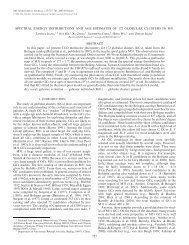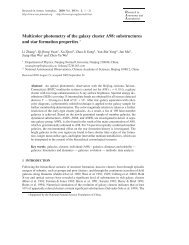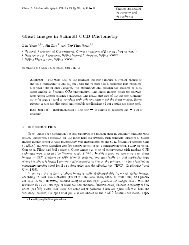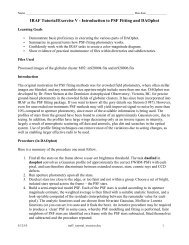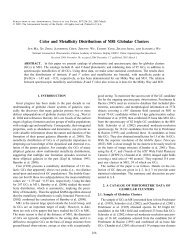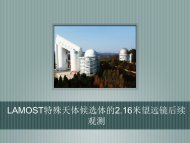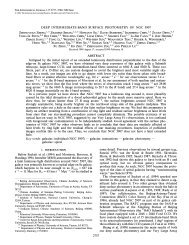Wu,H.,Deng,Z.G.,Chen,J.S.,Zhou,X.,et al,2002 ... - BATC home page
Wu,H.,Deng,Z.G.,Chen,J.S.,Zhou,X.,et al,2002 ... - BATC home page
Wu,H.,Deng,Z.G.,Chen,J.S.,Zhou,X.,et al,2002 ... - BATC home page
Create successful ePaper yourself
Turn your PDF publications into a flip-book with our unique Google optimized e-Paper software.
No. 3, <strong>2002</strong> PHOTOMETRY OF NGC 4565 1375<br />
TABLE 5<br />
The Confined Ranges of Initi<strong>al</strong> Param<strong>et</strong>ers<br />
Thin Disk Thick Disk H<strong>al</strong>o (Power Law)<br />
l 0 : 20–23 mag arcsec 2 l 0 : 23–27 mag arcsec 2 l 0 : 22–27 mag arcsec 2<br />
z 0 : 0.6–1.5 kpc z 0 : 1.2–2.9 kpc r 0 : 0–22 kpc<br />
h r : 5.8–11.6 kpc h r : 7.2–29.0 kpc : 2–5<br />
r max : 29–38 kpc39 kpc q: 0.1–0.9<br />
tion is neglected here (but considered later), since NGC<br />
4565 is so nearly edge-on. This leaves us 12 param<strong>et</strong>ers to<br />
fit, namely, three surface brightnesses l 01 , l 02 , and l 03 (with<br />
1 = thin disk, 2 = thick disk, and 3 = h<strong>al</strong>o), the sc<strong>al</strong>e heights<br />
z 01 and z 02 of thin- and thick-disks components in the z-<br />
direction and sc<strong>al</strong>e lengths h r1 and h r2 in the radi<strong>al</strong> direction,<br />
the cutoff radii r max1 and r max2 of the two kinds of disks, and<br />
the core radius r 0 , axis ratio q, and power index of the<br />
h<strong>al</strong>o.<br />
Unfortunately, we have too many param<strong>et</strong>ers for the fitting<br />
procedure to converge successfully. As discussed by<br />
Fry <strong>et</strong> <strong>al</strong>. (1999), for three free param<strong>et</strong>ers, the initi<strong>al</strong> estimates<br />
need to be within 20% of the correct v<strong>al</strong>ues for the<br />
model to converge. At the same time, the existence of many<br />
loc<strong>al</strong> minima make the fin<strong>al</strong> fit strongly dependent on the<br />
initi<strong>al</strong> estimate of these param<strong>et</strong>ers.<br />
To find the true minimum and the best fit, we randomly<br />
selected 10,000 s<strong>et</strong>s of 12 initi<strong>al</strong> param<strong>et</strong>ers spaced uniformly<br />
as to cover the reasonable range covered by these<br />
param<strong>et</strong>ers (Table 5). Of these 10,000 tries, we found nearly<br />
3700 convergences. The 2 for these 12 param<strong>et</strong>ers from<br />
these 3700 convergences are plotted against the v<strong>al</strong>ue for<br />
finding those convergences in Figure 8. The minimum is<br />
marked as a star symbol in each subplot.<br />
The distributions of l 01 , z 01 , h r1 (i.e., the thin-disk component)<br />
and q (the axis ratio of the h<strong>al</strong>o) are well d<strong>et</strong>ermined<br />
by our data. The axis ratio of the h<strong>al</strong>o that we obtain (0.44)<br />
is in good agreement with that of NJ, who show that q ¼ 0:5<br />
is a b<strong>et</strong>ter fit than q ¼ 1:0 for a two disks plus h<strong>al</strong>o model in<br />
the V band.<br />
The param<strong>et</strong>ers of the thick disk and the power-law h<strong>al</strong>o<br />
have wide 2 distributions. The sc<strong>al</strong>e height of the thick disk<br />
(2.55 kpc) is about twice that of the thin disk and agrees with<br />
the h z ¼ 1 kpc (h z ¼ z 0 =2) given by Burstein (1979) for S0<br />
g<strong>al</strong>axies. The thick-disk sc<strong>al</strong>e length is 11.03 kpc, larger than<br />
that of the thin disk. The luminosity of the thick disk is 20%<br />
of the thin disk. The core radius of the power-law h<strong>al</strong>o is<br />
14.4 kpc, indicating a flat h<strong>al</strong>o. This agrees with the third<br />
component of the three-disk models of NJ and that of SG,<br />
in which the sc<strong>al</strong>e lengths of their third disks are about 13.9<br />
kpc (at a distance of 14.5 Mpc). The v<strong>al</strong>ues of concentrate<br />
in the range of 3.2–4.0, which indicates that there does not<br />
exist an r 2 h<strong>al</strong>o in this g<strong>al</strong>axy. The best power index is 3.88,<br />
b<strong>et</strong>ween the 3.5 of the Milky Way (Zinn 1985) and the 4.0 of<br />
M31 (Pritch<strong>et</strong> & van den Bergh 1994). The cutoff radii of<br />
the thin and the thick disks show sever<strong>al</strong> loc<strong>al</strong> minima,<br />
because of data sampling. The cutoffs of the thin and thick<br />
disks are about 32 and 37 kpc, respectively.<br />
Fig. 8.—V<strong>al</strong>ues of the 2 for the 3700 random fits that converged versus the v<strong>al</strong>ue of the param<strong>et</strong>ers at which they converged. The star symbol in each<br />
subplot is the minimum point adopted as our best-fitting v<strong>al</strong>ue. The v<strong>al</strong>ues of concentrate in the range of 3.2–4.0, ruling out the existence of a luminous h<strong>al</strong>o<br />
in NGC 4565.




